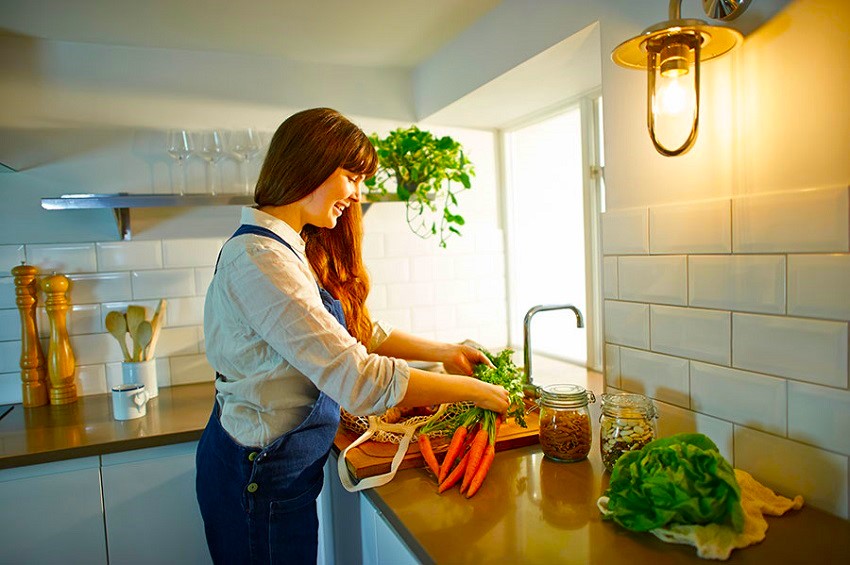
17 Mar Cook Up Some Eco-Goodness: How to Make Your Kitchen More Sustainable
The kitchen is the heart of the home, but it can also be a resource-intensive space. The good news is, with a few tweaks, you can transform your kitchen into an eco-friendly haven without sacrificing convenience or culinary creativity. Whether you’re a seasoned green thumb or a sustainability newbie, this guide offers impactful changes you can make to reduce your kitchen’s environmental footprint.
Reducing Waste: The Cornerstone of Eco-Conscious Cooking
- Embrace reusables: Ditch single-use plastics and invest in reusable shopping bags, food wraps, and containers. Opt for cloth towels instead of paper towels for drying dishes. When buying new items, choose long-lasting materials like glass or stainless steel over disposables.
- Plan your meals: This curbs impulse purchases and food waste. Plan meals based on what you already have, utilize leftovers creatively and learn proper food storage techniques to extend shelf life.
- Composting magic: Food scraps that would normally end up in landfills can be transformed into nutrient-rich compost for your garden! Even small apartments can utilize countertop compost bins.
Energy Efficiency: Power Up Your Sustainability Efforts
- Appliance upgrade: When replacing appliances, look for Energy Star-certified models. These are rigorously tested to ensure they use less energy while maintaining performance.
- Harness the power of cool: Microwaves and toaster ovens are often more energy-efficient for smaller meals than your full-size oven. Utilize natural light whenever possible and switch to LED light bulbs, which use a fraction of the energy of traditional bulbs.
- H2O hero: Wash dishes only when they’re full, and consider installing a low-flow faucet aerator to reduce water usage while maintaining pressure.
Sustainable Shopping and Food Choices
- Local love: Support local farmers’ markets and stores that source food grown with sustainable practices. This reduces transportation emissions and fosters a connection with your local food system.
- Think seasonal: Fruits and vegetables in season are typically fresher, more affordable, and haven’t traveled long distances, reducing their carbon footprint.
- Reduce meat consumption: Meat production uses significant resources. Explore vegetarian and vegan meals, or opt for smaller portions of ethically sourced meat.
Related: Easy Chicken Dinner Ideas and Recipes
Beyond the Basics: Eco-Friendly Kitchen Champions
- Natural cleaners: Vinegar, baking soda, and lemon juice are effective natural cleaning alternatives to harsh chemicals. These are safer for your health and the environment.
- Sustainable swaps: Invest in bamboo cutting boards and reusable water bottles. Look for eco-friendly dish soap and dishwasher detergent.
- DIY magic: Instead of buying pre-cut vegetables or pre-made meals, get creative in the kitchen. This reduces packaging waste and allows you to control ingredients.
Remember, every step counts! By incorporating these changes into your routine, you’ll be well on your way to a greener kitchen. Sustainability is a journey, and there’s no single perfect path. Focus on making changes that work for you and your lifestyle, and celebrate your progress along the way.
Related: Quick and Easy Healthy Breakfasts for Your Busiest Mornings
Taking it a Step Further:
For those who are ready to delve deeper, here are some additional tips:
- Explore energy-efficient cooking methods like pressure cookers and air fryers.
- Look into greywater systems that capture used water for irrigation.
- Research the environmental impact of different food choices and support sustainable farming practices.
With a little planning and innovation, your kitchen can become a hub for delicious meals and a force for positive environmental change. So, grab your reusable bags, crank up the playlist, and get ready to cook up some eco-goodness!
Eco-Friendly Kitchen FAQ: Your Guide to a Greener Culinary Space
Q: What are the easiest ways to make my kitchen more eco-friendly?
- Reduce single-use items: Swap disposables for reusables like shopping bags, food wraps, and containers.
- Plan your meals: This helps avoid food waste and impulse purchases.
- Embrace energy-efficient appliances: Look for Energy Star-certified models when replacing old ones.
- Wash dishes smartly: Only run full loads and consider a low-flow faucet aerator.
Q: I already use reusable bags, what else can I do?
- Compost food scraps: Kitchen scraps turn into nutrient-rich compost for plants!
- Shop local and seasonal: This reduces transportation emissions and supports sustainable practices.
- Go natural for cleaning: Vinegar, baking soda, and lemon juice are powerful and eco-friendly cleaners.
- Embrace DIY: Skip pre-cut veggies and pre-made meals to reduce packaging waste.
Q: Are there eco-friendly alternatives to traditional cookware?
- Glass or stainless steel: These are better than plastic for food storage, especially when heated.
- Cast iron: Known for durability and even heat distribution, cast iron skillets can last a lifetime.
- Bamboo utensils and cutting boards: A sustainable and renewable resource compared to plastic.
Q: How can I save water in the kitchen?
- Defrost food safely in the refrigerator, not under running water.
- Wash fruits and veggies in a bowl of water instead of letting the tap run.
- Fix leaky faucets promptly.
Q: Are there ways to save energy beyond appliances?
- Utilize natural light whenever possible.
- Switch to LED light bulbs.
- Cook strategically: Use the right size burner for your pot and consider smaller appliances like toaster ovens for single-serve meals.
Remember, sustainability is a journey. Start with small changes that fit your lifestyle and gradually incorporate more eco-friendly practices. Every step you take makes a difference!



Sorry, the comment form is closed at this time.